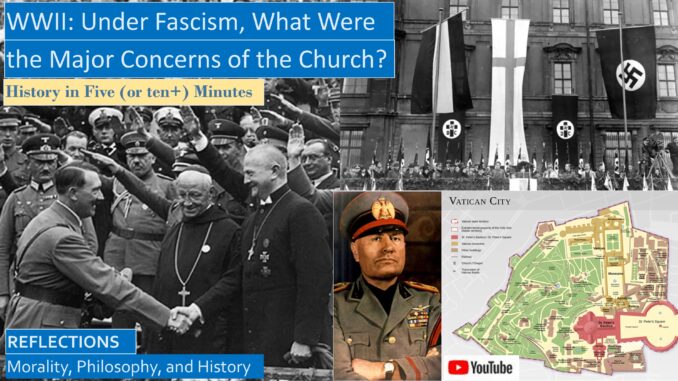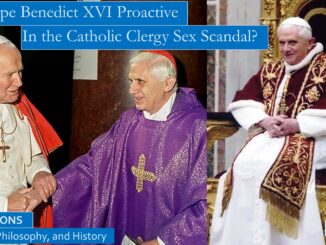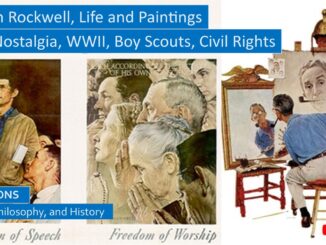
Under Fascism and Nazism, What were the major concerns of the church? The major concerns of the church were her survival, and whether Christians could worship without harassment.
Mussolini was the first fascist leader who seized power as a fascist leader, ruling as a El Duce, the dictator of Italy, subject only to the acquiescence of the constitutional monarch of Italy, King Victor Emmanuel III. He came to power over a decade before Hitler, he was an inspiration to Hitler in the early interwar years, Hitler had his bust on his desk.
This YouTube video: https://youtu.be/QZgIv9rNP_8
Main YouTube Video, Christians Keep the Faith in Nazi Germany: https://youtu.be/QP9UR8fqfvs
Fascists were the sworn enemies of the communists. Communists were the sworn enemies of the Christians, Lenin’s communists in Russia martyred more priests and Christians by the millions. Which meant that many in Europe saw the fascists as the friend of the church, since they were the enemies of the communists.
MUSSOLINI WAS INITIALLY A FRIEND OF THE CATHOLIC CHURCH
Before seizing power, Mussolini’s street gangs were known for beating up and even occasionally murdering priests. After he was elected as the head of the ruling coalition in Parliament, Mussolini surprised everyone by proclaiming that he was the friend of the church. Fascism, Mussolini proclaimed, would restore a Christian society in Italy. Fascism would build a Catholic state befitting a Catholic nation. The Pope decided swing his support to Mussolini, betraying the Catholic Center Party, because Mussolini appeared to be on the winning side in Italian politics. They remained allies after Mussolini seized absolute power as El Duce, supreme leader in Italy.
The Pope’s loyalty was rewarded, the Lateran accords creating the Vatican City were signed in early 1929. The papacy would receive a generous indemnity for the loss of the Papal States, but the Pope was recognized as the sovereign ruler over the Vatican. Catholic education would also be extended to secondary schools, and all Catholic Action youth groups could operate freely.
Relations between Mussolini and the pope would remain cordial until 1938, shortly before the outbreak of World War II, when Mussolini went full Nazi and started persecuting the Jews.
FASCIST GENERAL FRANCO WAS ALWAYS A FRIEND OF THE CATHOLIC CHURCH
The regime of General Franco was always seen as a friend of the Catholic Church. Both sides in the Spanish Civil War were brutal, both sides committed numerous massacres. While the Communists on the Republican side massacred priests, monks, and nuns by the thousands, the Nationalist under the fascist leader Franco massacred public schoolteachers and other liberals, socialists, and communists. Franco never persecuted the Jews, and Spain became a safe haven for Jews during the war.
The Spanish Civil War reinforced the attitude of many Europeans that fascists were protectors of the church.
The positive experience of the Catholic Church with the fascist regime of Mussolini’s Italy blinded Christians to the dangers posed by the Nazi Party when they were elected as part of the ruling coalition in Germany, with Hitler being appointed Chancellor in January 1933.
In February 1933 the Reichstag, the German Parliament building, caught fire, and the communists were blamed. During the political crisis that followed, Hitler needed a two-thirds vote to pass the Enabling Act that would name him dictator to deal with this crisis. Hitler gained the support of the pope and Protestants by promising to support Christianity in Germany. This was a promise quickly broken once Hitler became undisputed Fuhrer of Germany.
LESSON: FREEDOM TO WORSHIP WITHOUT HARASSMENT IS A MAJOR CONCERN OF THE CHURCH
Unlike the Fascist regimes of Italy, Spain, and Vichy France, who actively support the Catholic Church, the pagan Nazi regime in Germany harassed and persecuted all Christian Churches from its beginning. Hitler in the 1920 Nazi Party platform supported the notion of positive Christianity which sought to fuse Christianity with Nazi racial ideology. This was a Christianity without an Old Testament, an Aryan Christ who was not a Jew, an absorbing Nazi Christianity that would absorb all other Christian Churches, a Nazi Church that would glorify the fatherland. These Nazi leaning churches were known as German Christians, and they managed to gain control of many Protestant Evangelical Churches.
The Confessing Church movement formed to resist this pressure to Nazify the German Protestant Churches. The leading theologian of this movement was Karl Barth, then theology professor at Bonn, known for his groundbreaking Commentary on Romans. During a synod in 1934, Barth was the primary author of the Barmen Declaration, the main confession of the Confessing Church.
The Barmen Declaration declared that Jesus is the sole authority of the Church, not the Fuhrer; that the Word of God is the source of revelation, not Nazi ideology; and that the message and order of the Church should not be influenced by Nazi politics. German Christians had the freedom to disobey Nazi dictates when they conflicted with scriptural mandates.
These machinations caused many member churches to distance themselves from the national organization. Also deeply controversial were the racial policies that decreed that any converted Jew should be dismissed from the clergy and could not draw a state salary. Many churches were offended by the heavy-handed Nazi attempt to hijack the churches. Many of the churches were far more concerned with the fate of Jews who converted to Christianity than they were with the fate of all Jews.
The Confessing Church was not monolithic. Confessing Churches did not leave their denomination, they were a church within a church. Although the Confessing Church resisted Nazi encroachments into the church, it did not encourage political opposition to the Nazis. Some Confessing Church pastors refused to make any compromises, chief among them was Dietrich Bonhoeffer, who eventually was involved in the plot to assassinate Hitler and would die in a Gestapo prison near the end of the war. Bonhoeffer was also adamant that Christians should concern themselves with the fate of all Jews. Many Confessing Church pastors tried to stay off the radar, some pastors were even card-carrying members of the Nazi Party, which sometimes helped when they were harassed by the Gestapo.
CATHOLIC CHURCH IN NAZI GERMANY
The Nazi regime also harassed the Catholic Church, closing down all church schools and seizing all their printing presses.
There are many stories in my sources of brave Catholic and Protestant bishops and priests who stood up for the Christian ideals, some defending the rights and dignity of their Jewish brothers, many who died in Nazi concentration camps, martyrs for their Christian beliefs.
Prior to the Enabling Act Catholics in many German bishoprics were forbidden from joining the Nazi Party, Nazis were not welcome to attend funerals or other group functions in Nazi regalia with Nazi banners, and any Catholics who were known Nazi sympathizers were forbidden from receiving the sacraments. Since the Catholics acquiesced in the passage of the Enabling Act, these restrictions were relaxed and Catholics could support the Nazis and join the Nazi Party, and some did. Although there were definitely anti-Christian elements in the Nazi program, many Catholics were reassured by the Nazi reassertion of the values of religion (as the Nazis defined it) and the love of the fatherland, and the Nazi’s strong opposition to the godless Bolshevism. Why shouldn’t Hitler be trusted? After all, in Mein Kampf he said he was not interested in interfering with German religious institutions. But interfere he did.
The Pope had negotiated a Concordat with fascist Italy with generally positive results in the early years. Soon after the passage of the Enabling Act, Papen initiated negotiations for a German Concordat with the Vatican. There were many parallels between the two Concordats. Neither Mussolini nor Hitler were religious men, both were dictators of totalitarian police states with personality cults, both sought total control over their citizens, both sought to control the church, both fascist regimes employed thugs who harassed and persecuted Christians, and both Concordats were negotiated during times when both regimes openly committed murder to consolidate their power. In both instances the Pope, being suspicious of democracy, betrayed the Catholic political parties who supported the Church, instead choosing the fascist parties as likely political victors. But Mussolini generally kept his word, becoming a real partner with the Catholic Church up to the start of the war, whereas Hitler broke the terms of the Concordat before the ink had dried.
Hitler was more interested in how the news of the Concordat would be received diplomatically and in the newspapers than he was in the actual terms of the Concordat. Although there were intense negotiations, in the end the exact terms meant nothing to Hitler since he intended to break the terms of the Concordat immediately and with impunity, while expecting the Catholic Church to always conform to their part of the treaty.
The Concordat was finally approved in September 1934. The Concordat was a political victory for Hitler, the Catholic Church had put their stamp of approval on the Nazi regime. Maybe the Catholic Church was more likely to survive having negotiated the Concordat, but the church sold its soul and made resistance to the regime more problematic for Catholics. The consent to liquidate all Catholic organizations with a political program helped strengthen the Nazi regime. But both the German and Italian Concordats survived the end of the war, and they are still in effect today.
Just like in fascist Italy, after the Concordat was signed the church bells rung for special Thanksgiving masses celebrating the signing of the Concordat. Just like in fascist Italy, formations of SA and SS Nazi thugs with swastikas and banners marched into the churches alongside Catholic bishops and diplomats. Just like in fascist Italy, members of the Catholic organizations rushed to affirm their loyalties to the Nazi party and state.
LESSON: CHRISTIANS USUALLY MIRROR THE VALUES OF THEIR CULTURE
Many Christians are confused about what spiritual warfare means, but the definition of spiritual warfare in a relatively free modern society is simple: the spiritual battle is an eternal contest of who is going to influence whom. Will Christians push back on the godless influences surrounding them, slightly improving the virtues of those who they meet? Or will Christians allow the godless influences surrounding them to corrupt their love for their neighbor? Will their politics increase in them their love for their neighbor, or will their politics decrease their compassion for the poor, the sick, the immigrant, the unemployed, the imprisoned, the elderly, and those who do not look like them?
We see in the history of Christians in Nazi Germany, and Vichy France, that most Christians were not truly compassionate for the plight of the Jews. Understandably, most ordinary Christians in any age are far more concerned with their own survival and the safety and future of their children than they are for other groups. Those compassionate few who seek social justice for all are the remnant among us.
(NOTE: See individual blogs for YouTube videos cited for footnote references.)




Be the first to comment